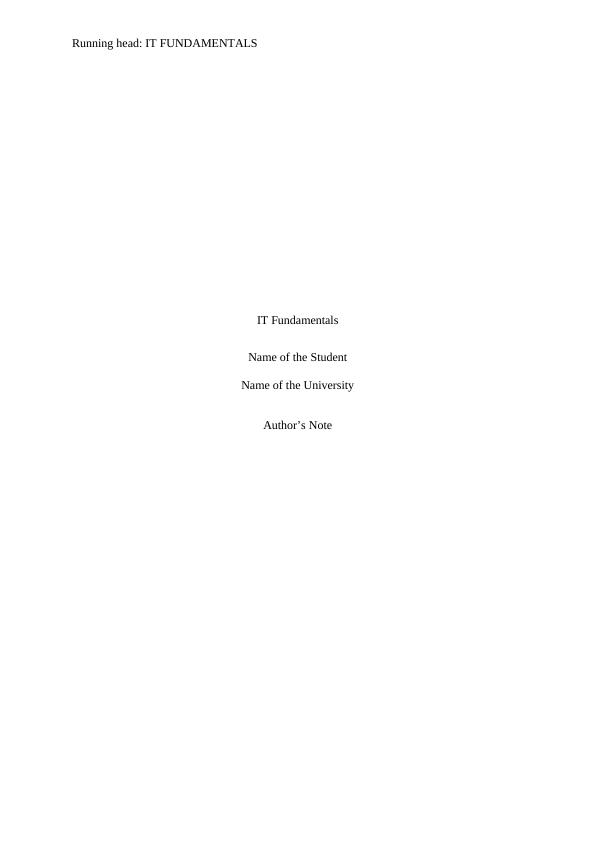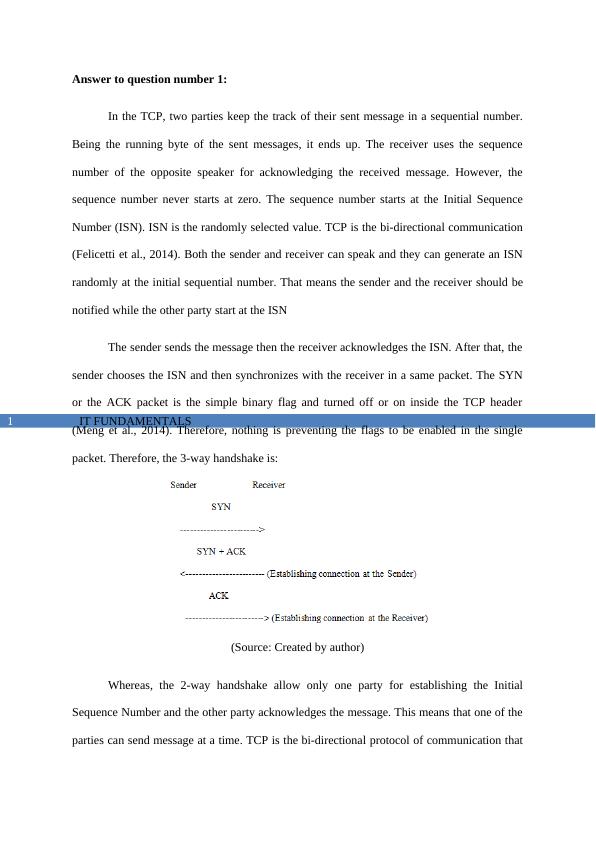IT Fundamentals Question Answer 2022
Added on 2022-10-03
8 Pages1902 Words17 Views
Running head: IT FUNDAMENTALS
IT Fundamentals
Name of the Student
Name of the University
Author’s Note
IT Fundamentals
Name of the Student
Name of the University
Author’s Note

IT FUNDAMENTALS1
Answer to question number 1:
In the TCP, two parties keep the track of their sent message in a sequential number.
Being the running byte of the sent messages, it ends up. The receiver uses the sequence
number of the opposite speaker for acknowledging the received message. However, the
sequence number never starts at zero. The sequence number starts at the Initial Sequence
Number (ISN). ISN is the randomly selected value. TCP is the bi-directional communication
(Felicetti et al., 2014). Both the sender and receiver can speak and they can generate an ISN
randomly at the initial sequential number. That means the sender and the receiver should be
notified while the other party start at the ISN
The sender sends the message then the receiver acknowledges the ISN. After that, the
sender chooses the ISN and then synchronizes with the receiver in a same packet. The SYN
or the ACK packet is the simple binary flag and turned off or on inside the TCP header
(Meng et al., 2014). Therefore, nothing is preventing the flags to be enabled in the single
packet. Therefore, the 3-way handshake is:
(Source: Created by author)
Whereas, the 2-way handshake allow only one party for establishing the Initial
Sequence Number and the other party acknowledges the message. This means that one of the
parties can send message at a time. TCP is the bi-directional protocol of communication that
Answer to question number 1:
In the TCP, two parties keep the track of their sent message in a sequential number.
Being the running byte of the sent messages, it ends up. The receiver uses the sequence
number of the opposite speaker for acknowledging the received message. However, the
sequence number never starts at zero. The sequence number starts at the Initial Sequence
Number (ISN). ISN is the randomly selected value. TCP is the bi-directional communication
(Felicetti et al., 2014). Both the sender and receiver can speak and they can generate an ISN
randomly at the initial sequential number. That means the sender and the receiver should be
notified while the other party start at the ISN
The sender sends the message then the receiver acknowledges the ISN. After that, the
sender chooses the ISN and then synchronizes with the receiver in a same packet. The SYN
or the ACK packet is the simple binary flag and turned off or on inside the TCP header
(Meng et al., 2014). Therefore, nothing is preventing the flags to be enabled in the single
packet. Therefore, the 3-way handshake is:
(Source: Created by author)
Whereas, the 2-way handshake allow only one party for establishing the Initial
Sequence Number and the other party acknowledges the message. This means that one of the
parties can send message at a time. TCP is the bi-directional protocol of communication that

IT FUNDAMENTALS2
means the end needs to be able for sending the message reliably. The sender and the receiver
need to establish the ISM and they should acknowledge each other’s ISN.
Answer to question number 2:
RAD stands for Rapid Application Development, which is a process and the adoption
of waterfall model. RAD targets the development of the software for a short time. RAD uses
the predefined prototyping techniques for producing the software application. RAD
encompasses the GUI (Graphical User Interface) development environment and allows the
end users for dragging the dropping the needed components of software application.
Advantages of RAD:
It is adaptable and flexible for changes.
Because of the code reuse and code generator, manual coding is reduced.
It becomes easy for transforming the deliverables as the scripts. Intermediate codes
and level abstraction are used (Kumar & Prashanth, 2014).
In reducing the entire project risk, it is very useful.
Each phase of RAD delivers the highest priority function to the clients.
Because of the prototyping in the nature, the defects become less.
With less number of people the productivity can maximized in short time.
Disadvantages of RAD:
Not every application is compatible with the RAD (Stoica, Mircea & Ghilic-Micu,
2013).
For smaller projects, RAD cannot be used.
Reduce the features because of the time boxing, where the features are pushed to the
next version for completing a release in the short time.
means the end needs to be able for sending the message reliably. The sender and the receiver
need to establish the ISM and they should acknowledge each other’s ISN.
Answer to question number 2:
RAD stands for Rapid Application Development, which is a process and the adoption
of waterfall model. RAD targets the development of the software for a short time. RAD uses
the predefined prototyping techniques for producing the software application. RAD
encompasses the GUI (Graphical User Interface) development environment and allows the
end users for dragging the dropping the needed components of software application.
Advantages of RAD:
It is adaptable and flexible for changes.
Because of the code reuse and code generator, manual coding is reduced.
It becomes easy for transforming the deliverables as the scripts. Intermediate codes
and level abstraction are used (Kumar & Prashanth, 2014).
In reducing the entire project risk, it is very useful.
Each phase of RAD delivers the highest priority function to the clients.
Because of the prototyping in the nature, the defects become less.
With less number of people the productivity can maximized in short time.
Disadvantages of RAD:
Not every application is compatible with the RAD (Stoica, Mircea & Ghilic-Micu,
2013).
For smaller projects, RAD cannot be used.
Reduce the features because of the time boxing, where the features are pushed to the
next version for completing a release in the short time.

End of preview
Want to access all the pages? Upload your documents or become a member.
Related Documents
Fundamentals of Information Technologylg...
|9
|2033
|489
Information Technology fundamentals Assignment1lg...
|10
|2372
|28
IT Fundamentals Report 2022lg...
|7
|1435
|22
IT Fundamentals: Network Protocols and SDLClg...
|7
|1323
|303
Fundamentals of Information Technologylg...
|8
|1728
|360
Mastering Network Protocols and ITSMlg...
|5
|1251
|1